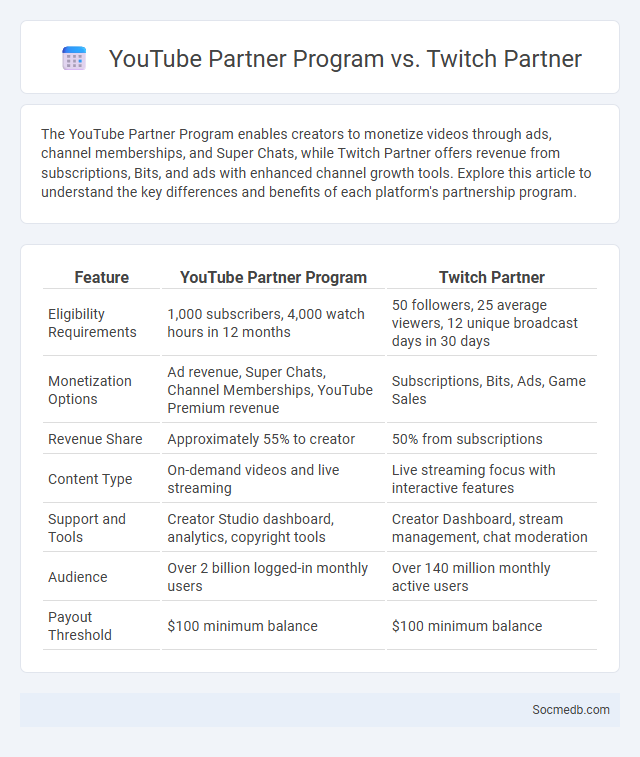
Photo illustration: YouTube Partner Program vs Twitch Partner
The YouTube Partner Program enables creators to monetize videos through ads, channel memberships, and Super Chats, while Twitch Partner offers revenue from subscriptions, Bits, and ads with enhanced channel growth tools. Explore this article to understand the key differences and benefits of each platform's partnership program.
Table of Comparison
| Feature | YouTube Partner Program | Twitch Partner |
|---|---|---|
| Eligibility Requirements | 1,000 subscribers, 4,000 watch hours in 12 months | 50 followers, 25 average viewers, 12 unique broadcast days in 30 days |
| Monetization Options | Ad revenue, Super Chats, Channel Memberships, YouTube Premium revenue | Subscriptions, Bits, Ads, Game Sales |
| Revenue Share | Approximately 55% to creator | 50% from subscriptions |
| Content Type | On-demand videos and live streaming | Live streaming focus with interactive features |
| Support and Tools | Creator Studio dashboard, analytics, copyright tools | Creator Dashboard, stream management, chat moderation |
| Audience | Over 2 billion logged-in monthly users | Over 140 million monthly active users |
| Payout Threshold | $100 minimum balance | $100 minimum balance |
Overview of Partner Programs: YouTube vs Twitch
YouTube Partner Program offers monetization through ads, channel memberships, and Super Chat, providing creators with diverse revenue streams and access to a vast global audience. Twitch Partner Program focuses on subscriptions, Bits donations, and ad revenue, enabling streamers to build strong communities through interactive live content. Your choice between YouTube and Twitch depends on your content style and desired engagement with followers in video versus live streaming environments.
Eligibility Criteria: Who Can Become a Partner?
Eligibility criteria for becoming a social media partner typically require individuals or entities to meet specific follower counts, content quality standards, and engagement metrics. Platforms often mandate a minimum number of active followers, consistent content creation aligned with community guidelines, and adherence to brand safety policies. Verification processes may include account authenticity checks and compliance with platform terms to ensure genuine partnerships.
Monetization Options: Revenue Streams Compared
Social media platforms generate revenue through diverse monetization options, including advertising, subscription models, and in-app purchases. Advertising remains the dominant revenue stream, with platforms like Facebook and Instagram leveraging targeted ads based on user data. Subscription services such as YouTube Premium and exclusive content features on Patreon provide alternate income sources, while gaming and social commerce within apps contribute significantly to overall earnings.
Content Requirements and Community Guidelines
Social media platforms enforce strict content requirements to ensure user safety, including prohibitions against hate speech, misinformation, and explicit material. Community guidelines mandate respectful interactions, discourage harassment, and promote authentic content creation to foster a positive online environment. Compliance with these rules is essential for maintaining platform integrity and avoiding account suspensions or content removal.
Application Process: Step-by-Step Comparison
The application process for social media platforms varies but generally involves creating an account, verifying your identity through email or phone, and customizing your profile with personal information and preferences. You should compare steps such as required verification methods, privacy settings configuration, and initial content posting options across platforms like Facebook, Instagram, Twitter, and LinkedIn to determine which suits your needs best. Understanding these differences helps streamline your experience and ensures your social media presence is optimized right from the start.
Partner Benefits and Exclusive Features
Accessing social media platforms tailored for partnerships unlocks exclusive features designed to enhance your collaboration experience, such as advanced analytics, dedicated support, and co-branded content tools. These partner benefits streamline communication, boost engagement, and provide valuable insights to help you optimize your campaigns effectively. Leveraging these unique capabilities ensures your social media strategy delivers measurable results and stronger brand alliances.
Payment Structure and Revenue Share
Social media platforms typically utilize a payment structure based on advertising revenue, where revenue share models allocate a percentage of ad earnings to content creators depending on engagement metrics like views, clicks, or shares. Your earnings can vary significantly based on the platform's revenue share policy, audience size, and content type, making it essential to understand each platform's specifics for optimizing monetization. Many platforms offer tiered payment structures that reward high-performing creators with increased revenue shares, encouraging quality content and consistent audience interaction.
Support and Resources for Partners
Social media platforms offer extensive support and resources tailored specifically for partners to maximize collaboration and growth. You can access dedicated partner portals, training modules, and real-time analytics tools designed to enhance campaign performance and audience engagement. Leveraging these resources ensures your partnership thrives through continuous learning and effective communication.
Growth Opportunities and Platform Tools
Maximizing growth opportunities on social media requires leveraging platform-specific tools like Instagram's Insights, Facebook Ads Manager, and LinkedIn Analytics to analyze audience behavior and optimize content strategy. Utilizing features such as Instagram Reels, Facebook Groups, and LinkedIn Live can increase engagement and expand your reach effectively. Your ability to integrate these tools with targeted, data-driven campaigns will significantly enhance brand visibility and follower growth.
Which Partner Program Is Right for You?
Choosing the right social media partner program depends on your content niche, audience size, and monetization goals. Platforms like YouTube Partner Program, Facebook for Creators, and TikTok Creator Fund each offer unique benefits tailored to various engagement levels and content types. Evaluating your specific needs and audience demographics will help you maximize revenue potential and growth through the most suitable partner program.
 socmedb.com
socmedb.com